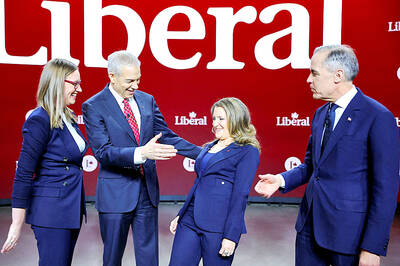An obscure UN board that oversees a US$2.7 billion market intended to cut heat-trapping gases has agreed to take steps that could lead to it eventually reining in what European and US environmentalists are calling a huge scam.
At a meeting last week that ended on Friday, the executive board of the UN’s Clean Development Mechanism (CDM) said that five chemical plants in China would no longer qualify for funding as so-called carbon offset credits until the environmentalists’ claims can be further investigated.
The CDM credits have been widely used in the carbon trading markets of the EU, Japan and other nations that signed onto the 1997 Kyoto Protocol requiring mandatory cuts in greenhouse gases.
Rather than cut their own carbon emissions, industrialized nations can buy the credits which then pay developing countries to cut their greenhouse gases instead.
However, environmentalists say rich nations could be wasting billions of dollars on what some are calling “perverse financial incentives,” because some of the largest projects funded by the UN-managed CDM are a golden goose for chemical makers without making meaningful cuts in emissions.
The CDM executive board, based in Bonn, Germany, has asked for a decades’ worth of data on the gases from those five plants in China to study whether the system was manipulated.
The controversy revolves around the apparent conflict between the Kyoto climate treaty and another UN treaty, the 1987 Montreal Protocol for repairing the Earth’s fragile ozone layer.
The money from the CDM-authorized fund goes to pay the carbon offset credits claimed by more than 20 chemical makers mostly in China and India, but also in nations such as South Korea, Argentina and Mexico.
The chemical makers are paid as much as US$100,000 or more for every tonne they destroy of a potent greenhouse gas, HFC-23. The price for destroying it is based on its being 11,700 times more powerful as a climate-warming gas than carbon dioxide.
However, that gas is a byproduct of an ozone-friendly refrigerant, HCFC-22, which those chemical makers also are paid to produce under the UN’s ozone treaty. Environmentalists say there is so much money in getting rid of HFC-23 that the chemical makers are overproducing HCFC-22 to have more of the byproduct to destroy.
“The evidence is overwhelming that manufacturers are creating excess HFC-23 simply to destroy it and earn carbon credits,” said Mark Roberts of the Environmental Investigation Agency, a research and advocacy group. “This is the biggest environmental scandal in history and makes an absolute mockery of international efforts to combat climate change.”
HCFC-22 is widely used in hair sprays, air conditioners and some refrigerators because it less damaging to the seasonal ozone hole over Antarctica than previous coolants. It has been promoted under the ozone treaty, often considered one of the world’s most successful environmental treaties, as a replacement for chloroflourocarbons, or CFCs.
Also See: Summer of extremes points to global warming as the culprit

When Shanghai-based designer Guo Qingshan posted a vacation photo on Valentine’s Day and captioned it “Puppy Mountain,” it became a sensation in China and even created a tourist destination. Guo had gone on a hike while visiting his hometown of Yichang in central China’s Hubei Province late last month. When reviewing the photographs, he saw something he had not noticed before: A mountain shaped like a dog’s head rested on the ground next to the Yangtze River, its snout perched at the water’s edge. “It was so magical and cute. I was so excited and happy when I discovered it,” Guo said.

TURNAROUND: The Liberal Party had trailed the Conservatives by a wide margin, but that was before Trump threatened to make Canada the US’ 51st state Canada’s ruling Liberals, who a few weeks ago looked certain to lose an election this year, are mounting a major comeback amid the threat of US tariffs and are tied with their rival Conservatives, according to three new polls. An Ipsos survey released late on Tuesday showed that the left-leaning Liberals have 38 percent public support and the official opposition center-right Conservatives have 36 percent. The Liberals have overturned a 26-point deficit in six weeks, and run advertisements comparing the Conservative leader to Trump. The Conservative strategy had long been to attack unpopular Canadian Prime Minister Justin Trudeau, but last month he

Chinese authorities said they began live-fire exercises in the Gulf of Tonkin on Monday, only days after Vietnam announced a new line marking what it considers its territory in the body of water between the nations. The Chinese Maritime Safety Administration said the exercises would be focused on the Beibu Gulf area, closer to the Chinese side of the Gulf of Tonkin, and would run until tomorrow evening. It gave no further details, but the drills follow an announcement last week by Vietnam establishing a baseline used to calculate the width of its territorial waters in the Gulf of Tonkin. State-run Vietnam News

THIRD ANNIVERSARY OF WAR: Ursula von der Leyen said that Europe was in Kyiv because ‘it is not only the destiny of Ukraine that is at stake. It’s Europe’s destiny’ A dozen leaders from Europe and Canada yesterday visited Ukraine’s capital to mark the third anniversary of Russia’s invasion in a show of support for Kyiv by some of its most important backers. European Commission President Ursula von der Leyen and Canadian Prime Minister Justin Trudeau were among the visitors greeted at the railway station by Ukrainian Minister of Foreign Affairs Andrii Sybiha and the president’s chief of staff Andrii Yermak. Von der Leyen wrote on social media that Europe was in Kyiv “because Ukraine is in Europe.” “In this fight for survival, it is not only the destiny of Ukraine that is